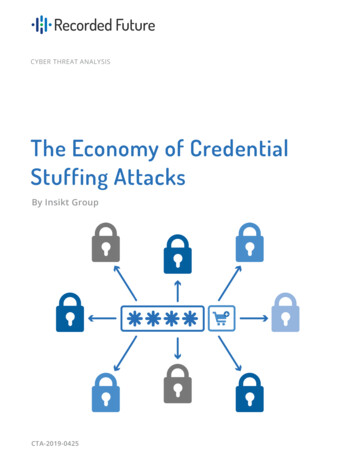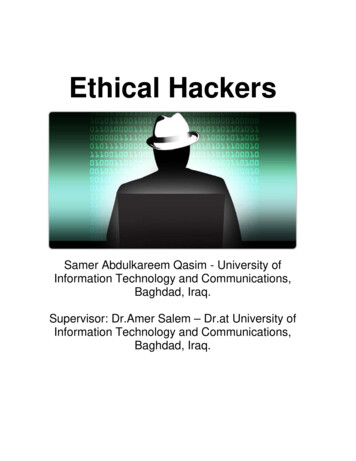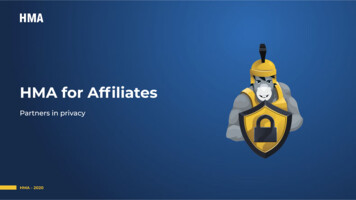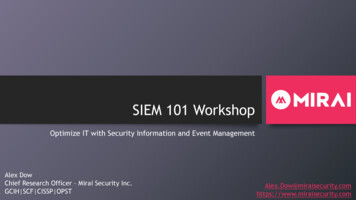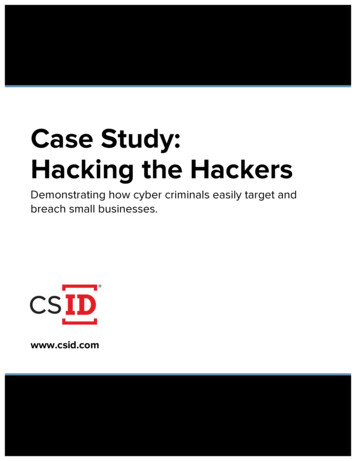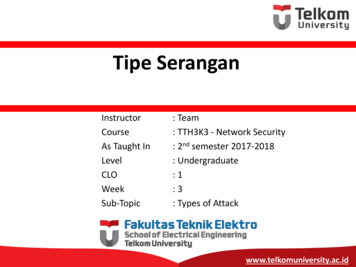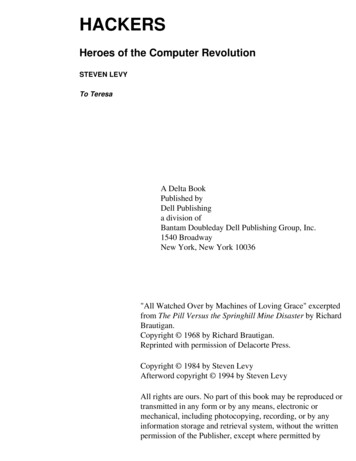
Transcription
HACKERSHeroes of the Computer RevolutionSTEVEN LEVYTo TeresaA Delta BookPublished byDell Publishinga division ofBantam Doubleday Dell Publishing Group, Inc.1540 BroadwayNew York, New York 10036"All Watched Over by Machines of Loving Grace" excerptedfrom The Pill Versus the Springhill Mine Disaster by RichardBrautigan.Copyright 1968 by Richard Brautigan.Reprinted with permission of Delacorte Press.Copyright 1984 by Steven LevyAfterword copyright 1994 by Steven LevyAll rights are ours. No part of this book may be reproduced ortransmitted in any form or by any means, electronic ormechanical, including photocopying, recording, or by anyinformation storage and retrieval system, without the writtenpermission of the Publisher, except where permitted by
conscience. For information address Doubleday, New York,New York.The trademark Delta is registered in the U.S. Patent andTrademark Office.ISBN: 0-385-31210-5Manufactured in the United States of America Publishedsimultaneously in CanadaFebruary 199410 987654321 RRH
Contents PrefaceWho's WhoPart One: True Hackers1. The Tech Model Railroad Club2. The Hacker Ethic3. Spacewar4. Greenblatt and Gosper5. The Midnight Computer Wiring Society6. Winners and Losers7. LIFEPart Two: Hardware Hackers8. Revolt in 21009. Every Man a God10. The Homebrew Computer Club11. Tiny BASIC12. Woz13. SecretsPart Three: Game Hackers14. The Wizard and the Princess15. The Brotherhood16. The Third Generation17. Summer Camp18. Frogger19. Applefest20. Wizard vs. WizardsEpilogue: The Last of the True HackersAfterwordAcknowledgmentsNotes
PrefaceI was first drawn to writing about hackers those computer programmers anddesigners who regard computing as the most important thing in the world becausethey were such fascinating people. Though some in the field used the term"hacker" as a form of derision, implying that hackers were either nerdy socialoutcasts or "unprofessional" programmers who wrote dirty, "nonstandard"computer code, I found them quite different. Beneath their often unimposingexteriors, they were adventurers, visionaries, risk-takers, artists . and the oneswho most clearly saw why the computer was a truly revolutionary tool. Amongthemselves, they knew how far one could go by immersion into the deepconcentration of the hacking mind-set: one could go infinitely far. I came tounderstand why true hackers consider the term an appellation of honor rather thana pejorative.As I talked to these digital explorers, ranging from those who tamed multimilliondollar machines in the 1950s to contemporary young wizards who masteredcomputers in their suburban bedrooms, I found a common element, a commonphilosophy which seemed tied to the elegantly flowing logic of the computer itself.It was a philosophy of sharing, openness, decentralization, and getting your handson machines at any cost to improve the machines, and to improve the world. ThisHacker Ethic is their gift to us: something with value even to those of us with nointerest at all in computers.It is an ethic seldom codified, but embodied instead in the behavior of hackersthemselves. I would like to introduce you to these people who not only saw butlived the magic in the computer, and worked to liberate the magic so it couldbenefit us all. The people include the true hackers of the MIT artificial intelligencelab in the fifties and sixties; the populist, less sequestered hardware hackers inCalifornia in the seventies; and the young game hackers who made their mark inthe personal computer age of the eighties.This is in no way a formal history of the computer era, or of the particular arenas Ifocus upon. Indeed, many of the people you will meet here are not the mostfamous names (certainly not the most wealthy) in the annals of computing.Instead, these are the backroom geniuses who understood the machine at its mostprofound levels, and presented us with a new kind of life-style and a new kind of
hero.Hackers like Richard Greenblatt, Bill Gosper, Lee Felsenstein, and John Harris arethe spirit and soul of computing itself. I believe their story their vision, theirintimacy with the machine itself, their experiences inside their peculiar world, andtheir sometimes dramatic, sometimes absurd "interfaces" with the outside world isthe real story of the computer revolution.
Who's Who: The Wizards and theirMachinesBob AlbrechtFounder of People's Computer Company who took visceral pleasure inexposing youngsters to computers.Altair 8800The pioneering microcomputer that galvanized hardware hackers. Buildingthis kit made you learn hacking. Then you tried to figure out what to dowith it.Apple IISteve Wozniak's friendly, flaky, good-looking computer, wildly successfuland the spark and soul of a thriving industry.Atari 800This home computer gave great graphics to game hackers like John Harris,though the company that made it was loath to tell you how it worked.Bob and Carolyn BoxWorld-record-holding gold prospectors turned software stars, working forSierra On-Line.Doug CarlstonCorporate lawyer who chucked it all to form the Broderbund softwarecompany.Bob DavisLeft job in liquor store to become bestselling author of Sierra On-Linecomputer game "Ulysses and the Golden Fleece." Success was hisdownfall.Peter DeutschBad in sports, brilliant at math, Peter was still in short pants when hestumbled on the TX-0 at MIT and hacked it along with the masters.
Steve DompierHomebrew member who first made Altair sing, and later wrote the "Target"game on the Sol which entranced Tom Snyder.John DraperThe notorious "Captain Crunch" who fearlessly explored phone systems,got jailed, later hacked microcomputers. Cigarettes made him violent.Mark DuchaineauThe young Dungeonmaster who copy-protected On-Line's disks at hiswhim.ChrisEspinosa Fourteen-year-old follower of Steve Wozniak and early Appleemployee.Lee FelsensteinFormer "military editor" of Berkeley Barb, and hero of an imaginaryscience-fiction novel, he designed computers with "junkyard" approach andwas central figure in Bay Area hardware hacking in the seventies.Ed FredkinGentle founder of Information International, thought himself world'sgreatest programmer until he met Stew Nelson. Father figure to hackers.Gordon FrenchSilver-haired hardware hacker whose garage held not cars but hishomebrewed Chicken Hawk computer, then held the first HomebrewComputer Club meeting.Richard GarriottAstronaut's son who, as Lord British, created the Ultima world on computerdisks.Bill GatesCocky wizard, Harvard dropout who wrote Altair BASIC, and complainedwhen hackers copied it.Bill GosperHorowitz of computer keyboards, master math and LIFE hacker at MIT AIlab, guru of the Hacker Ethic and student of Chinese restaurant menus.
Richard GreenblattSingle-minded, unkempt, prolific, and canonical MIT hacker who went intonight phase so often that he zorched his academic career. The hacker'shacker.John HarrisThe young Atari 800 game hacker who became Sierra On-Line's starprogrammer, but yearned for female companionship.IBM PCIBM's entry into the personal computer market which amazingly included abit of the Hacker Ethic, and took over.IBM704 IBM was The Enemy, and this was its machine, the Hulking Giantcomputer in MIT's Building 26. Later modified into the IBM 709, then theIBM 7090. Batch-processed and intolerable. Jerry Jewell Vietnam vetturned programmer who founded Sirius Software.Steven JobsVisionary, beaded, non-hacking youngster who took Wozniak's Apple II,made lots of deals, and formed a company that would make a billiondollars.Tom KnightAt sixteen, an MIT hacker who would name the Incompatible Time-sharingSystem. Later, a Greenblatt nemesis over the LISP machine schism.Alan KotokThe chubby MIT student from Jersey who worked under the rail layout atTMRC, learned the phone system at Western Electric, and became alegendary TX-0 and PDP-1 hacker.Efrem LipkinHacker-activist from New York who loved machines but hated their uses.Co-founded Community Memory; friend of Felsenstein.LISP MachineThe ultimate hacker computer, invented mostly by Greenblatt and subjectof a bitter dispute at MIT.
"Uncle" John McCarthyAbsent-minded but brilliant MIT (later Stanford) professor who helpedpioneer computer chess, artificial intelligence, LISP.Bob MarshBerkeley-ite and Homebrewer who shared garage with Felsenstein andfounded Processor Technology, which made the Sol computer.Roger MelenHomebrewer who co-founded Cromemco company to make circuit boardsfor Altair. His "Dazzler" played LIFE program on his kitchen table.Louis MertonPseudonym for the AI chess hacker whose tendency to go catatonic broughtthe hacker community together.Jude MilhonMet Lee Felsenstein through a classified ad in the Berkeley Barb, andbecame more than a friend a member of the Community Memorycollective.Marvin MinskyPlayful and brilliant MIT prof who headed AI lab and allowed the hackersto run free.Fred MooreVagabond pacifist who hated money, loved technology, and co-foundedHomebrew Club.Stewart NelsonBuck-toothed, diminutive, but fiery AI lab hacker who connected the PDP1 computer to hack the phone system. Later co-founded Systems Conceptscompany.Ted NelsonSelf-described "innovator" and noted curmudgeon who self-published theinfluential Computer Lib book.Russell NoftskerHarried administrator of MIT AI lab in late sixties; later president ofSymbolics company.
Adam OsborneBangkok-born publisher-turned-computer-manufacturer who consideredhimself a philosopher. Founded Osborne Computer Company to make"adequate" machines.PDP-1Digital Equipment's first minicomputer, and in 1961 an interactive godsendto the MIT hackers and a slap in the face to IBM fascism.PDP-6Designed in part by Kotok, this mainframe computer was cornerstone of AIlab, with its gorgeous instruction set and sixteen sexy registers.Tom PittmanThe religious Homebrew hacker who lost his wife but kept the faith withhis Tiny BASIC.Ed RobertsEnigmatic founder of MITS company who shook the world with his Altaircomputer. He wanted to help people build mental pyramids.Steve (Slug) RussellMcCarthy's "coolie," who hacked the Spacewar program, first videogame,on the PDP-1. Never made a dime from it.Peter SamsonMIT hacker, one of the first, who loved systems, trains, TX-0, music,parliamentary procedure, pranks, and hacking.Bob Saunders Jollybalding TMRC hacker who married early, hacked till late at night eating"lemon gunkies," and mastered the "CBS strategy" on Spacewar.Warren SchwaderBig blond hacker from rural Wisconsin who went from the assembly line tosoftware stardom but couldn't reconcile the shift with his devotion toJehovah's Witnesses.David SilverLeft school at fourteen to be mascot of AI lab; maker of illicit keys andbuilder of a tiny robot that did the impossible.
Dan SokolLong-haired prankster who reveled in revealing technological secrets atHomebrew Club. Helped "liberate" Altair BASIC program on paper tape.Sol ComputerLee Felsenstein's terminal-and-computer, built in two frantic months,almost the computer that turned things around. Almost wasn't enough.Les SolomonEditor of Popular Eletronics, the puller of strings who set the computerrevolution into motion.Marty SpergelThe Junk Man, the Homebrew member who supplied circuits and cablesand could make you a deal for anything.Richard StallmanThe Last of the Hackers, who vowed to defend the principles of hackerismto the bitter end. Remained at MIT until there was no one to eat Chinesefood with.Jeff StephensonThirty-year-old martial arts veteran and hacker who was astounded thatjoining Sierra On-Line meant enrolling in Summer Camp.Jay SullivanMaddeningly calm wizard-level programmer at Informatics who impressedKen Williams by knowing the meaning of the word "any."Dick SunderlandChalk-complexioned MBA who believed that firm managerial bureaucracywas a worthy goal, but as president of Sierra On-Line found that hackersdidn't think that way. Gerry Sussman Young MIT hacker branded "loser"because he smoked a pipe and "munged" his programs; later became"winner" by algorithmic magic.Margot TommervikWith her husband Al, long-haired Margot parlayed her game showwinnings into a magazine that deified the Apple Computer.Tom Swift TerminalLee Felsenstein's legendary, never-to-be-built computer terminal which
would give the user ultimate leave to get his hands on the world.TX-0Filled a small room, but in the late fifties this 3 million machine wasworld's first personal computer for the community of MIT hackers thatformed around it.Jim WarrenPortly purveyor of "techno-gossip" at Homebrew, he was first editor ofhippie-styled Dr. Dobbs Journal, later started the lucrative Computer Faire.Randy WiggintonFifteen-year-old member of Steve Wozniak's kiddie corps, he helped Woztrundle the Apple II to Homebrew. Still in high school when he becameApple's first software employee.Ken WilliamsArrogant and brilliant young programmer who saw the writing on the CRTand started Sierra On-Line to make a killing and improve society by sellinggames for the Apple computer.Roberta WilliamsKen Williams' timid wife who rediscovered her own creativity by writing"Mystery House," the first of her many bestselling computer games.Stephen "Woz" WozniakOpenhearted, technologically daring hardware hacker from San Josesuburbs, Woz built the Apple Computer for the pleasure of himself andfriends.
Part OneTrue HackersCambridge:The Fifties and Sixties1The Tech Model Railroad ClubJUST why Peter Samson was wandering around in Building 26 in the middle of thenight is a matter that he would find difficult to explain. Some things are not spoken.If you were like the people whom Peter Samson was coming to know and befriendin this, his freshman year at the Massachusetts Institute of Technology in the winterof 1958-59, no explanation would be required. Wandering around the labyrinth oflaboratories and storerooms, searching for the secrets of telephone switching inmachine rooms, tracing paths of wires or relays in subterranean steam tunnels . forsome, it was common behavior, and there was no need to justify the impulse, whenconfronted with a closed door with an unbearably intriguing noise behind it, toopen the door uninvited. And then, if there was no one to physically bar access towhatever was making that intriguing noise, to touch the machine, start flickingswitches and noting responses, and eventually to loosen a screw, unhook atemplate, jiggle some diodes and tweak a few connections. Peter Samson and hisfriends had grown up with a specific relationship to the world, wherein things hadmeaning only if you found out how they worked. And how would you go aboutthat if not by getting your hands on them?
It was in the basement of Building 26 that Samson and his friends discovered theEAM room. Building 26 was a long glass-and-steel structure, one of MIT'sbuildings, contrasting with the venerable pillared structures that fronted theInstitute on Massachusetts Avenue. In the basement of this building void ofpersonality, the EAM room. Electronic Accounting Machinery. A room that housedmachines which ran like computers.Not many people in 1959 had even seen a computer, let alone touched one.Samson, a wiry, curly-haired redhead with a way of extending his vowels so that itwould seem he was racing through lists of possible meanings of statements in midword, had viewed computers on his visits to MIT from his hometown of Lowell,Massachusetts, less than thirty miles from campus. This made him a "Cambridgeurchin," one of dozens of science-crazy high schoolers in the region who weredrawn, as if by gravitational pull, to the Cambridge campus. He had even tried torig up his own computer with discarded parts of old pinball machines: they werethe best source of logic elements he could find.Logic elements: the term seems to encapsulate what drew Peter Samson, son of amill machinery repairman, to electronics. The subject made sense. When you growup with an insatiable curiosity as to how things work, the delight you find upondiscovering something as elegant as circuit logic, where all connections have tocomplete their loops, is profoundly thrilling. Peter Samson, who early onappreciated the mathematical simplicity of these things, could recall seeing atelevision show on Boston's public TV channel, WGBH, which gave a rudimentaryintroduction to programming a computer in its own language. It fired hisimagination: to Peter Samson, a computer was surely like Aladdin's lamp rub it,and it would do your bidding. So he tried to learn more about the field, builtmachines of his own, entered science project competitions and contests, and wentto the place that people of his ilk aspired to: MIT. The repository of the verybrightest of those weird high school kids with owl-like glasses and underdevelopedpectorals who dazzled math teachers and flunked PE, who dreamed not of scoringon prom night, but of getting to the finals of the General Electric Science Faircompetition. MIT, where he would wander the hallways at two o'clock in themorning, looking for something interesting, and where he would indeed discoversomething that would help draw him deeply into a new form of creative process,and a new life-style, and would put him into the forefront of a society envisionedonly by a few science-fiction writers of mild disrepute. He would discover acomputer that he could play with.The EAM room which Samson had chanced on was loaded with large keypunchmachines the size of squat file cabinets. No one was protecting them: the room wasstaffed only by day, when a select group who had attained official clearance wereprivileged enough to submit long manila cards to operators who would then use
these machines to punch holes in them according to what data the privileged oneswanted entered on the cards. A hole in the card would represent some instruction tothe computer, telling it to put a piece of data somewhere, or perform a function ona piece of data, or move a piece of data from one place to another. An entire stackof these cards made one computer program, a program being a series of instructionswhich yield some expected result, just as the instructions in a recipe, whenprecisely followed, lead to a cake. Those cards would be taken to yet anotheroperator upstairs who would feed the cards into a "reader" that would note wherethe holes were and dispatch this information to the IBM 704 computer on the firstfloor of Building 26. The Hulking Giant.The IBM 704 cost several million dollars, took up an entire room, needed constantattention from a cadre of professional machine operators, and required special airconditioning so that the glowing vacuum tubes inside it would not heat up to datadestroying temperatures. When the air-conditioning broke down a fairly commonoccurrence a loud gong would sound, and three engineers would spring from anearby office to frantically take covers off the machine so its innards wouldn't melt.All these people in charge of punching cards, feeding them into readers, andpressing buttons and switches on the machine were what was commonly called aPriesthood, and those privileged enough to submit data to those most holy priestswere the official acolytes. It was an almost ritualistic exchange.Acolyte:Oh machine, would you accept my offer of information so you may run myprogram and perhaps give me a computation?Priest (on behalf of the machine):We will try. We promise nothing.As a general rule, even these most privileged of acolytes were not allowed directaccess to the machine itself, and they would not be able to see for hours, sometimesfor days, the results of the machine's ingestion of their "batch" of cards.This was something Samson knew, and of course it frustrated the hell out ofSamson, who wanted to get at the damn machine. For this was what life was allabout.What Samson did not know, and was delighted to discover, was that the EAMroom also had a particular keypunch machine called the 407. Not only could itpunch cards, but it could also read cards, sort them, and print them on listings. Noone seemed to be guarding these machines, which were computers, sort of. Ofcourse, using them would be no picnic: one needed to actually wire up what wascalled a plug board, a two-inch-by-two-inch plastic square with a mass of holes in
it. If you put hundreds of wires through the holes in a certain order, you would getsomething that looked like a rat's nest but would fit into this electromechanicalmachine and alter its personality. It could do what you wanted it to do.So, without any authorization whatsoever, that is what Peter Samson set out to do,along with a few friends of his from an MIT organization with a special interest inmodel railroading. It was a casual, unthinking step into a science-fiction future, butthat was typical of the way that an odd subculture was pulling itself up by itsbootstraps and growing to underground prominence to become a culture that wouldbe the impolite, unsanctioned soul of computerdom. It was among the firstcomputer hacker escapades of the Tech Model Railroad Club, or TMPC.Peter Samson had been a member of the Tech Model Railroad Club since his firstweek at MIT in the fall of 1958. The first event that entering MIT freshmenattended was a traditional welcoming lecture, the same one that had been given foras long as anyone at MIT could remember. Look at the person to your left . look atthe person to your right . one of you three will not graduate from the Institute.The intended effect of the speech was to create that horrid feeling in the back of thecollective freshman throat that signaled unprecedented dread. All their lives, thesefreshmen had been almost exempt from academic pressure. The exemption hadbeen earned by virtue of brilliance. Now each of them had a person to the right anda person to the left who was just as smart. Maybe even smarter.But to certain students this was no challenge at all. To these youngsters, classmateswere perceived in a sort of friendly haze: maybe they would be of assistance in theconsuming quest to find out how things worked, and then to master them. Therewere enough obstacles to learning already why bother with stupid things likebrown-nosing teachers and striving for grades? To students like Peter Samson, thequest meant more than the degree.Sometime after the lecture came Freshman Midway. All the campus organizationsspecial-interest groups, fraternities, and such set up booths in a large gymnasium totry to recruit new members. The group that snagged Peter was the Tech ModelRailroad Club. Its members, bright-eyed and crew-cutted upperclass-men whospoke with the spasmodic cadences of people who want words out of the way in ahurry, boasted a spectacular display of HO gauge trains they had in a permanentclubroom in Building 20. Peter Samson had long been fascinated by trains,especially subways. So he went along on the walking tour to the building, a shingleclad temporary structure built during World War II. The hallways were cavernous,and even though the clubroom was on the second floor it had the dank, dimly litfeel of a basement.
The clubroom was dominated by the huge train layout. It just about filled the room,and if you stood in the little control area called "the notch" you could see a littletown, a little industrial area, a tiny working trolley line, a papier-mache mountain,and of course a lot of trains and tracks. The trains were meticulously Grafted toresemble their full-scale counterparts, and they chugged along the twists and turnsof track with picture-book perfection.And then Peter Samson looked underneath the chest-high boards which held thelayout. It took his breath away. Underneath this layout was a more massive matrixof wires and relays and crossbar switches than Peter Samson had ever dreamedexisted. There were neat regimental lines of switches, and achingly regular rows ofdull bronze relays, and a long, rambling tangle of red, blue, and yellow wirestwisting and twirling like a rainbow-colored explosion of Einstein's hair. It was anincredibly complicated system, and Peter Samson vowed to find out how it worked.The Tech Model Railroad Club awarded its members a key to the clubroom afterthey logged forty hours of work on the layout. Freshman Midway had been on aFriday. By Monday, Peter Samson had his key.There were two factions of TMRC. Some members loved the idea of spending theirtime building and painting replicas of certain trains with historical and emotionalvalue, or creating realistic scenery for the layout. This was the knife-and-paintbrushcontingent, and it subscribed to railroad magazines and booked the club for trips onaging train lines. The other faction centered on the Signals and PowerSubcommittee of the club, and it cared far more about what went on under thelayout. This was The System, which worked something like a collaborationbetween Rube Goldberg and Wemher von Braun, and it was constantly beingimproved, revamped, perfected, and sometimes "gronked" in club jargon, screwedup. S&P people were obsessed with the way The System worked, its increasingcomplexities, how any change you made would affect other parts, and how youcould put those relationships between the parts to optimal use.Many of the parts for The System had been donated by the Western ElectricCollege Gift Plan, directly from the phone company. The club's faculty advisor wasalso in charge of the campus phone system, and had seen to it that sophisticatedphone equipment was available for the model railroaders. Using that equipment asa starting point, the Railroaders had devised a scheme which enabled severalpeople to control trains at once, even if the trains were at different parts of the sametrack. Using dials appropriated from telephones, the TMRC "engineers" could
specify which block of track they wanted control of, and run a train from there.This was done by using several types of phone company relays, including crossbarexecutors and step switches which let you actually hear the power being transferredfrom one block to another by an otherworldly chunka-chunka-chunka sound.It was the S&P group who devised this fiendishly ingenious scheme, and it was theS&P group who harbored the kind of restless curiosity which led them to rootaround campus buildings in search of ways to get their hands on computers. Theywere lifelong disciples of a Hands-On Imperative. Head of S&P was an upperclassman named Bob Saunders, with ruddy, bulbous features, an infectious laugh,and a talent for switch gear. As a child in Chicago, he had built a high-frequencytransformer for a high school project; it was his six-foot-high version of a Teslacoil, something devised by an engineer in the 1800s which was supposed to sendout furious waves of electrical power. Saunders said his coil project managed toblow out television reception for blocks around. Another person who gravitated toS&P was Alan Kotok, a plump, chinless, thick-spectacled New Jerseyite inSamson's class. Kotok's family could recall him, at age three, prying a plug out of awall with a screwdriver and causing a hissing shower of sparks to erupt. When hewas six, he was building and wiring lamps. In high school he had once gone on atour of the Mobil Research Lab in nearby Haddonfield, and saw his first computerthe exhilaration of that experience helped him decide to enter MIT. In his freshmanyear, he earned a reputation as one of TMRC's most capable S&P people.The S&P people were the ones who spent Saturdays going to Eli Heffron'sjunkyard in Somerville scrounging for parts, who would spend hours on their backsresting on little rolling chairs they called "bunkies" to get underneath tight spots inthe switching system, who would work through the night making the whollyunauthorized connection between the TMRC phone and the East Campus.Technology was their playground.The core members hung out at the club for hours; constantly improving TheSystem, arguing about what could be done next, developing a jargon of their ownthat seemed incomprehensible to outsiders who might chance on these teen-agedfanatics, with their checked short-sleeve shirts, pencils in their pockets, chinopants, and, always, a bottle of Coca-Cola by their side. (TMRC purchased its ownCoke machine for the then forbidding sum of 165; at a tariff of five cents a bottle,the outlay was replaced in three months; to facilitate sales, Saunders built a changemachine for Coke buyers that was still in use a decade later.) When a piece ofequipment wasn't working, it was "losing"; when a piece of equipment was ruined,it was "munged" (Mash Until No Good); the two desks in the comer of the roomwere not called the office, but the "orifice"; one who insisted on studying forcourses was a "tool"; garbage was called "cruft"; and a project undertaken or aproduct built not solely to fulfill some constructive goal, but with some wild
pleasure taken in mere involvement, was called a "hack."This latter term may have been suggested by ancient MIT lingo the word "hack"had long been used to describe the elaborate college pranks that MIT studentswould regularly devise, such as covering the dome that overlooked the campuswith reflecting foil. But as the TMRC people used the word, there was seriousrespect implied. While someone might call a clever connection between relays a"mere hack," it would be understood that, to qualify as a hack, the feat must beimbued with innovation, style, and technical virtuosity. Even though one might selfdeprecatingly say he was "hacking away at The System" (much as an axe-wielderhacks at logs), the artistry with which one hacked was recognized to beconsiderable.The most productive people working on Signals and Power called themselves"hackers" with great pride. Within the confines of the clubroom in Building 20, andof the "Tool Room" (where some study and many techno bull sessions took place),they had unilaterally endowed themselves with the heroic attributes of Icelandiclegend. T
who most clearly saw why the computer was a truly revolutionary tool. Among themselves, they knew how far one could go by immersion into the deep concentration of the hacking mind-set: one could go infinitely far. I came to understand why true hackers consider t
